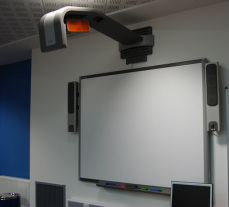Reporting of the field trip
At the beginning of our trip a representative of the school told us some general information. The school has about 1300 pupils at the moment and 125 teachers work there although only about 60 of them work on a full-time basis. In comparison to other schools in Hesse, the MLS is a little bit behind other schools when it concerns technical devices or new media. They have got an electronic cover plan on two flat screens situated at different places in the school but there is also a classical version of this in written format if there are technical problems. Ten rooms are equipped with a flatscreen TVs that are also connected to a DVD-Player and a sound system. These TVs are hidden behind a wooden box so that the students cannot access them without the key of the teacher. Moreover you can connect a laptop to the TV via VGA cable. The school is stocked with two computer labs and five workspaces for pupils in the library as well as two computers in the staff room. Apart from those computers there are two media-kits which are portable projector-laptop-audio-systems. And last but not least, there are two SMART boards, especially for the biology and art faculty but other staff members can also use them if they want to.
The first thing, that stroke me, in the beginning of our tour was when the representative told us about how everything is structured in the staff room- with many different folders and shelves- and that there is almost no online organization. A little bit later we were told that the school has a website where teachers can enter the dates for class tests and where they can also check whether a specific media is available at that time. Those can be booked for example the PW-suitcases, a digital camera or a data projectors. Although this system is not mature yet, I think it is highly recommended for every school since it saves a lot of hassle to find out whether one medium is available or another staff-member is using it at that time.
The first thing, that stroke me, in the beginning of our tour was when the representative told us about how everything is structured in the staff room- with many different folders and shelves- and that there is almost no online organization. A little bit later we were told that the school has a website where teachers can enter the dates for class tests and where they can also check whether a specific media is available at that time. Those can be booked for example the PW-suitcases, a digital camera or a data projectors. Although this system is not mature yet, I think it is highly recommended for every school since it saves a lot of hassle to find out whether one medium is available or another staff-member is using it at that time.

The availability to gain access to the internet is limited. They have got an average bandwidth but if 30 students use it at once it will be very slow. There is the possibility to go online via cable in every in almost every room of the school but I think WLAN would be more appropriate because students could also gain access for matters of research. It would make sense if students are not allowed to go online the whole time but only when the teacher wants them to do so. Therefore the WLAN should be password protected.
This idea brings me to the point that the acquirement of mew media devices is always connected with the issue of money. According to representative, one flatscreen-TV with a DVD-Player and a sound system is worth about 1000€ and one SMART board about 4000€. Thereupon the following question arises: Does new media bring our teaching a decisive step forward?
This idea brings me to the point that the acquirement of mew media devices is always connected with the issue of money. According to representative, one flatscreen-TV with a DVD-Player and a sound system is worth about 1000€ and one SMART board about 4000€. Thereupon the following question arises: Does new media bring our teaching a decisive step forward?
With regards to SMART boards, it is not the case. The devices have not reached a technological standard that are needed for valuable education. They are helpful and offer many possibilities but according to the MLS representative they are not a substitute for blackboards yet.
At the end of our tour there was little time left but we had the possibility to ask questions. I found out that in school lessons mobile phones are prohibited. One the one hand, phones are problematic for example like "happy slapping" or the use of phones in class tests but one the other hand many teachers use mobile phones for picture stories (Q 4). I think that mobiles offer a lot of possibilities in school and they should be used wisely. I found an interesting article called "Taschenfunk" at medienbildung.com which gives helpful ideas how mobiles can be included into school lessons.
At the end of our tour there was little time left but we had the possibility to ask questions. I found out that in school lessons mobile phones are prohibited. One the one hand, phones are problematic for example like "happy slapping" or the use of phones in class tests but one the other hand many teachers use mobile phones for picture stories (Q 4). I think that mobiles offer a lot of possibilities in school and they should be used wisely. I found an interesting article called "Taschenfunk" at medienbildung.com which gives helpful ideas how mobiles can be included into school lessons.

Via email, I also asked about the frequency of media used at the MLS (Q 1), after-school projects (Q 3) and Q 4 which answers I would like to shortly summarize.
Q1) The Computer labs were used about 30 hours per week during April and May manly by the department of computer science but also German, history, biology, English, mathematics as well as music.
The SMART boards are only used by about 10 teachers who often explicitly ask for them.
It is interesting that by now the computer labs are used a lot but interactive SMART boards, that are pilloried by didacts, are not. I suppose that the expenditure of time is too high for most of the teachers to prepare their classes or they are not interested in using them, not trained or even afraid of trying something new. In the future, the trend will definitely hint towards SMART boards like it is already the case in some schools where they replaced traditional blackboards.
Q 3) The school offers a "Homepage- AG" and a "Schulzeitung- AG" although I do not know if the latter is electronic or printed.
Q 4) They start a "Lehrgang" during 6th grade and deepen their knowledge in grade 7. There is also an obligatory parents-teacher meeting about Internet security, data security and cyberbullying. Moreover these topics are discussed in various teaching subjects or by the head- teacher of each class.
To me, it seems that the school is aware of the problematic use of Internet at the school and at home because they start raising awareness of that topic early. At my school time I have not been introduced to these topics and so it is good to see that something has changed.
This should give you an overview of our field trip to the MLS. New media offers many chances for education but we should always think about the risks and financial issues they involve and about their actual use. Everybody has to make up his own mind whether he/she wants to use SMART boards which are effective in use but time-consuming in terms of preparations for various classes or if they want to use other media. For me, a student of mathematics and English, SMART boards are definitely chance for alternative methods and diverse lessons.
Q1) The Computer labs were used about 30 hours per week during April and May manly by the department of computer science but also German, history, biology, English, mathematics as well as music.
The SMART boards are only used by about 10 teachers who often explicitly ask for them.
It is interesting that by now the computer labs are used a lot but interactive SMART boards, that are pilloried by didacts, are not. I suppose that the expenditure of time is too high for most of the teachers to prepare their classes or they are not interested in using them, not trained or even afraid of trying something new. In the future, the trend will definitely hint towards SMART boards like it is already the case in some schools where they replaced traditional blackboards.
Q 3) The school offers a "Homepage- AG" and a "Schulzeitung- AG" although I do not know if the latter is electronic or printed.
Q 4) They start a "Lehrgang" during 6th grade and deepen their knowledge in grade 7. There is also an obligatory parents-teacher meeting about Internet security, data security and cyberbullying. Moreover these topics are discussed in various teaching subjects or by the head- teacher of each class.
To me, it seems that the school is aware of the problematic use of Internet at the school and at home because they start raising awareness of that topic early. At my school time I have not been introduced to these topics and so it is good to see that something has changed.
This should give you an overview of our field trip to the MLS. New media offers many chances for education but we should always think about the risks and financial issues they involve and about their actual use. Everybody has to make up his own mind whether he/she wants to use SMART boards which are effective in use but time-consuming in terms of preparations for various classes or if they want to use other media. For me, a student of mathematics and English, SMART boards are definitely chance for alternative methods and diverse lessons.
Paragraph. Zum Bearbeiten hier klicken .

